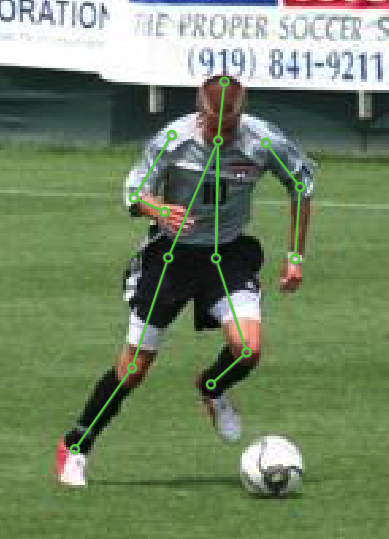Leeds Sports Pose#
This topic describes how to manage the Leeds Sports Pose Dataset, which is a dataset with Keypoints2D label(Fig. 3).

Fig. 3 The preview of an image with labels from “Leeds Sports Pose”.#
Create Dataset#
gas.create_dataset("LeedsSportsPose")
Organize Dataset#
Normally, dataloader.py and catalog.json are required to organize the “Leeds Sports Pose” dataset into the Dataset instance.
In this example, they are stored in the same directory like:
Leeds Sports Pose/
catalog.json
dataloader.py
Step 1: Write the Catalog#
A catalog contains all label information of one dataset, which
is typically stored in a json file like catalog.json.
1{
2 "KEYPOINTS2D": {
3 "keypoints": [
4 {
5 "number": 14,
6 "names": [
7 "Right ankle",
8 "Right knee",
9 "Right hip",
10 "Left hip",
11 "Left knee",
12 "Left ankle",
13 "Right wrist",
14 "Right elbow",
15 "Right shoulder",
16 "Left shoulder",
17 "Left elbow",
18 "Left wrist",
19 "Neck",
20 "Head top"
21 ],
22 "skeleton": [
23 [0, 1],
24 [1, 2],
25 [3, 4],
26 [4, 5],
27 [6, 7],
28 [7, 8],
29 [9, 10],
30 [10, 11],
31 [12, 13],
32 [12, 2],
33 [12, 3]
34 ],
35 "visible": "BINARY"
36 }
37 ]
38 }
39}
The only annotation type for “Leeds Sports Pose” is Keypoints2D.
Note
By passing the path of the catalog.json, load_catalog() supports loading the catalog into dataset.
Important
See catalog table for more catalogs with different label types.
Step 2: Write the Dataloader#
A dataloader is needed to organize the dataset into
a Dataset instance.
1#!/usr/bin/env python3
2#
3# Copyright 2021 Graviti. Licensed under MIT License.
4#
5# pylint: disable=invalid-name
6
7"""Dataloader of LeedsSportsPose dataset."""
8
9import os
10
11from tensorbay.dataset import Data, Dataset
12from tensorbay.exception import ModuleImportError
13from tensorbay.geometry import Keypoint2D
14from tensorbay.label import LabeledKeypoints2D
15from tensorbay.opendataset._utility import glob
16
17DATASET_NAME = "LeedsSportsPose"
18
19
20def LeedsSportsPose(path: str) -> Dataset:
21 """`Leeds Sports Pose <http://sam.johnson.io/research/lsp.html>`_ dataset.
22
23 The folder structure should be like::
24
25 <path>
26 joints.mat
27 images/
28 im0001.jpg
29 im0002.jpg
30 ...
31
32 Arguments:
33 path: The root directory of the dataset.
34
35 Raises:
36 ModuleImportError: When the module "scipy" can not be found.
37
38 Returns:
39 Loaded :class:`~tensorbay.dataset.dataset.Dataset` instance.
40
41 """
42 try:
43 from scipy.io import loadmat # pylint: disable=import-outside-toplevel
44 except ModuleNotFoundError as error:
45 raise ModuleImportError(module_name=error.name) from error
46
47 root_path = os.path.abspath(os.path.expanduser(path))
48
49 dataset = Dataset(DATASET_NAME)
50 dataset.load_catalog(os.path.join(os.path.dirname(__file__), "catalog.json"))
51 segment = dataset.create_segment()
52
53 mat = loadmat(os.path.join(root_path, "joints.mat"))
54
55 joints = mat["joints"].T
56 image_paths = glob(os.path.join(root_path, "images", "*.jpg"))
57 for image_path in image_paths:
58 data = Data(image_path)
59 data.label.keypoints2d = []
60 index = int(os.path.basename(image_path)[2:6]) - 1 # get image index from "im0001.jpg"
61
62 keypoints = LabeledKeypoints2D()
63 for keypoint in joints[index]:
64 keypoints.append(Keypoint2D(keypoint[0], keypoint[1], int(not keypoint[2])))
65
66 data.label.keypoints2d.append(keypoints)
67 segment.append(data)
68 return dataset
See Keipoints2D annotation for more details.
There are already a number of dataloaders in TensorBay SDK provided by the community. Thus, in addition to writing, importing an available dataloader is also feasible.
from tensorbay.opendataset import LeedsSportsPose
dataset = LeedsSportsPose("<path/to/dataset>")
Note
Note that catalogs are automatically loaded in available dataloaders, users do not have to write them again.
Important
See dataloader table for dataloaders with different label types.
Visualize Dataset#
Optionally, the organized dataset can be visualized by Pharos, which is a TensorBay SDK plug-in. This step can help users to check whether the dataset is correctly organized. Please see Visualization for more details.
Upload Dataset#
The organized “BSTLD” dataset can be uploaded to TensorBay for sharing, reuse, etc.
dataset_client = gas.upload_dataset(dataset, jobs=8)
dataset_client.commit("initial commit")
Similar with Git, the commit step after uploading can record changes to the dataset as a version. If needed, do the modifications and commit again. Please see Version Control for more details.
Read Dataset#
Now “Leeds Sports Pose” dataset can be read from TensorBay.
dataset = Dataset("LeedsSportsPose", gas)
In dataset “Leeds Sports Pose”, there is one
segment named default. Get it by passing the segment name or the index.
segment = dataset[0]
In the default segment, there is a sequence of data, which can be obtained by index.
data = segment[0]
In each data, there is a sequence of Keypoints2D annotations, which can be obtained by index.
label_keypoints2d = data.label.keypoints2d[0]
x = data.label.keypoints2d[0][0].x
y = data.label.keypoints2d[0][0].y
v = data.label.keypoints2d[0][0].v
There is only one label type in “Leeds Sports Pose” dataset, which is keypoints2d. The information stored in x (y) is
the x (y) coordinate of one keypoint of one keypoints list. The information stored in v is
the visible status of one keypoint of one keypoints list. See Keypoints2D
label format for more details.
Delete Dataset#
gas.delete_dataset("LeedsSportsPose")